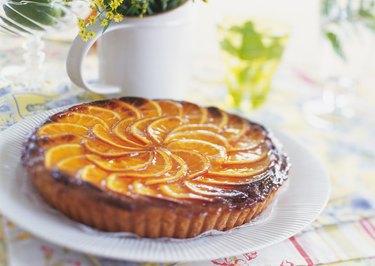
The baker's vocabulary includes a number of specialized terms, which can often seem bafflingly similar to novices. Consider the example of tortes and tarts. Although both terms refer to desserts, and they rely for the most part on conventional ingredients such as flour, eggs and sugar, the finished products are very different. Tortes are fundamentally a cake, while tarts are pie-like.
Torte Basics
Video of the Day
Despite the confusingly named linzertorte, which is actually a rich pie, tortes are assembled from cake or cake-like layers. They're usually larger in diameter than American layer cakes, at 10 to 12 inches, and with a few exceptions are relatively flat, at 2 to 3 inches in height. The individual layers are often of thin sponge cake, but they're variable. Traditional recipes might incorporate quantities of ground nuts or even crumbs from leftover cake, and some famous tortes use nut-filled meringues to form the layers. Buttercream is the most common filling between layers, but custards, preserves and chocolate ganache are also widely used. The torte might be left open at the sides, or sealed like a regular cake in buttercream or ganache.
Video of the Day
Topless Tarts
The line between tarts and pies is blurred, but for two key distinctions. First, tarts are typically made in a shallower pan with straight sides; and second, they don't have a top crust. Tart pans are usually fluted at the edge, for decorative effect, and often -- but not always -- have lift-out bottoms to make it easier to remove the finished product from your pan. The fillings might be custard- or fruit-based, at the baker's discretion, but should be visually attractive in their own right. Though the tart shouldn't have a full crust, bakers sometimes add decorative cut-outs or a thin lattice for added appeal.